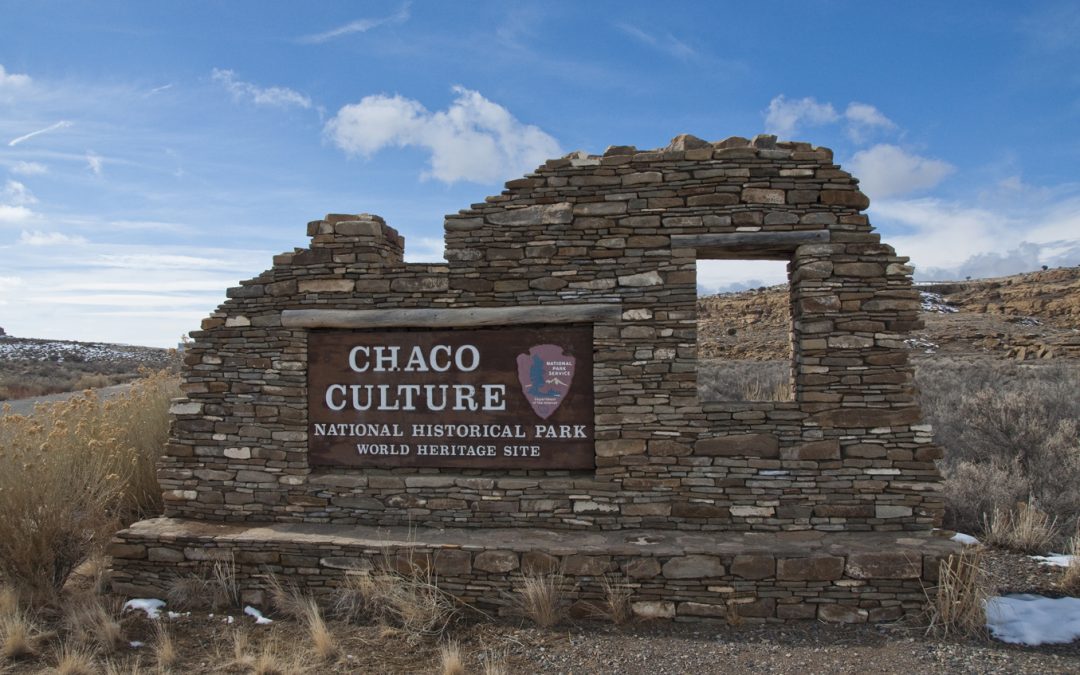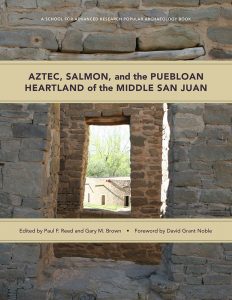Chaco Canyon was the center of a thriving Pueblo society from 800 to 1250 CE, including dozens of magnificent great house structures, numerous small pueblos, many kilometers of constructed roadways, and thousands of other cultural and historic sites. Chaco Culture National Historic Park is one of only twenty-four UNESCO World Heritage Sites in the United States, attesting to its importance and significance on a world scale. Unfortunately, Chaco and the Greater Chaco Landscape are currently threatened by expanded oil and gas exploration and drilling. To protect Chaco and the Greater Chaco Landscape, federal agencies must restrict oil-gas activities around Chaco’s boundary and put in place a permanent moratorium on new energy leasing in a ten-mile zone of protection around the park and its outlying communities.
—Paul F. Reed, preservation archaeologist and co-editor of Aztec, Salmon, and the Puebloan Heartland of the Middle San Juan (SAR Press, 2018)
“For me, it all starts with landscape,” says Ruth Van Dyke, SAR’s 2000–2001 NEH resident scholar and a professor of anthropology at SUNY Binghamton, who believes that archaeologists are integral to the process of raising public awareness about ancient cultural sites like Chaco Canyon, in northwestern New Mexico. As SAR’s 2020 Linda S. Cordell lecturer, she spoke about her decades of research within the Chaco Canyon region and shared her insights into past and present social, political, and sensorial relationships across the Greater Chaco Landscape. She is the author of The Chaco Experience: Landscape and Ideology at the Center Place (SAR Press, 2008) and one of many SAR scholars who have studied and advocated for Chaco Canyon over the last hundred years.
In a conversation with Meredith Schweitzer, SAR’s director of communications and public programs, Van Dyke described how the Ancestral Puebloan builders in Chaco Canyon were trying to create a “sense of place that emphasized Chaco as the center. Chaco was the fulcrum, and you can see this on the landscape.” Great houses jut up into the sky, great kivas sink down into the earth, architecture facilitates observation of astronomical events, roads reach out in the landscape like spokes on a great wheel. “And what that would have done for the elites or designers or residents of Chaco,” adds Van Dyke, “was legitimate their place as the center of everything and as the people who are in touch with the forces that are important. To keep the world in balance.”


Photos of Chaco Canyon (top, Pueblo Bonito), courtesy of Stephen Lekson.
She went on to describe the “industrial landscape” of the San Juan Basin, most of which is being leased by the Bureau of Land Management for oil, gas, and mineral extraction. These industries build roads that crisscross the basin and change both viewscapes and the soundscapes that may have played essential roles in the social and ritual life of Chaco. Educating students and the public about these impacts is important, of course, but Van Dyke believes that a “more interesting conversation could be had around the role of archaeology and political action. My colleagues in archaeology, some of them take the stance that archaeologists are objective scientists and it’s understandable why people might want to adopt that attitude, but my stance is that all archaeology is political whether you want it to be or not. That knowledge is still being used or not used in certain ways that ultimately will end up being political. So everybody has a position whether they want to admit it or not. As an archaeologist, I do have a position, and so I think it is important for me to acknowledge that and use my platform, use the skills that I have, to get the message out there.”
Throughout this journey over the last six or seven years, one of the things that really emerged was the very deep emotional and spiritual connection that my Native colleagues have, whether they’re Diné or Pueblo, with Chaco and with a sense of place. As an American archaeologist, I’m coming in as a colonial interloper. And I can get as passionate as I want about the viewscapes and soundscapes, but it’s still not my ancestors. And so the most important thing that I plan to do moving forward is to use my position to provide spaces for Native voices. At the end of the day, it’s really the Native ancestors and the Native voices that are most important here.
You can learn more about meaning of Chaco Canyon, past and present, at our virtual events this spring. Patricia Crown, SAR 2019–2020 Weatherhead fellow and the Leslie Spier Distinguished Professor of Anthropology at the University of New Mexico, has just published The House of the Cylinder Jars: Room 28 in Pueblo Bonito, Chaco Canyon (UNM Press, 2020). She and several of the contributors recently discussed their work during a special virtual book talk with SAR.
On April 23 at 4:00 p.m. (MST), archaeologists Paul Reed and Gary Brown will be talking about Aztec, Salmon, and the Puebloan Heartland of the Middle San Juan (SAR Press, 2018) from our Popular Archaeology series, in which they and their contributors describe life in several Chaco outlier communities and the relationship of these communities to the people and culture of the canyon.
On April 1 at 2:00 p.m., Stephen Lekson will begin teaching a three-part SAR In-Depth Course on the archaeology of Chaco Canyon:
After five decades studying Chaco (on and off!) I think I’ve learned some useful things about the place. Not just Chaco Canyon, but its region and its history. My “findings,” alas, are scattered all over the place: some in this book, some in that book, more in various articles, and key parts only in presentations and videos. This class gives me the chance to pull it all together and to present it all in one place—something I’ve never before done.

Photo of stairs at Pueblo Alto, Chaco Canyon, courtesy of Stephen Lekson.
The history of a century Chaco archaeology is critical to understanding our evolving views of the place (Session One). Then, the fundamental “matter” of Chaco: architecture, both in the canyon and over its larger reason (Session Two). That evidence underwrites my understanding of what Chaco was, really (Session Three). And last, Chaco’s larger history: where it came from, what it did, and where it went—including, of course, Indigenous accounts I’ve been privileged to hear (Session Four).
Chaco is a World Heritage site, but in many ways its region—the Chacoan landscape—is even more remarkable. And absent the protections of a national park, very much at risk. Others have addressed its heritage values; I spend a little time talking about Chaco’s archaeological significance. In the grand scheme of things, Chaco is not a marvel or wonder—it’s a fairly common human social arrangement. But together with the remarkable (current) preservation of its region, Chaco is nearly unique archaeologically.
In the meantime, you can catch up on more of our recent Chaco-related reading and events:
- Chacoan Astronomy, Cosmography, Roads, and Ritual Power: Insights into the Chaco World Using New Technologies with Anna Sofaer, Richard Friedman, and Robert Weiner
- Chaco and Chocolate: SAR Impacts with Archaeologist Patricia Crown
- Chaco Landscapes: Sensory and Political Engagement with Place with Ruth Van Dyke
- SAR Press Top Reads: Chaco Canyon
(Feature photo by John Fowler, February 5, 2010, unaltered, https://creativecommons.org/licenses/by/2.0/deed.en.)



